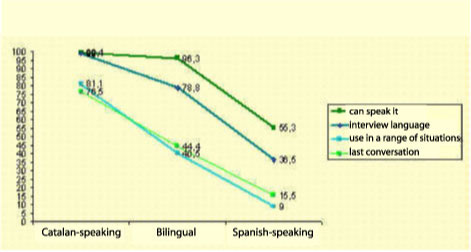
| Sociolingüística catalana |
| Linguistic uses and identity in Catalonia, by Albert Fabà, Olga Gàlvez, Joan Manrúbia and Noemí Ubach | ||||
| CONTINUA |
This result is that 72% of interviewees answered the survey in Catalan – a much higher value than the "real" use of Catalan, and than the value of people who consider their language to be Catalan, or both Catalan and Spanish (which, added together, represent around 60% of the population of Catalonia). It is very clear then that inertia and letting oneself be carried along, so long as the context is favourable for Catalan, can substantially increase the indices of use. If we intersect the language in which the interview was conducted with linguistic identity, the result is Figure 12. Figure 12. Language of interview and linguistic identity. 2000. Percentages
To conclude, it would be useful to summarise our findings. We will do so with the help of a final diagram using the main results of this section on non-domestic use (although we have also included data on oral competence), along with the variable that we have most used to make intersections: linguistic identity. Figure 13. Competence, use and linguistic identity. 2000. Percentages
We shall now move on to make our observations. 1) The difference in use, in line with linguistic identity, is very clear in all cases: competence, use in certain situations, the language of the last conversation or that of the interview. Catalan-speakers always come in first place, followed by bilingual individuals with the Spanish-speakers bringing up the rear. 1) Except in the case of Catalan-speakers (for whom competence and the interview language are absolutely level), the data is grouped into three blocks. The highest indices are offered by linguistic competence, followed by the interview language and finally use in a range of situations and the language of the last conversation. 2) In short, if we had to choose an index of use of Catalan, the best indicator would be the average of two values, with an approximate value of 5 points, if we opted for a scale of 0 to 10. 3) This index, although strongly determined by linguistic identity, as we said earlier, is not entirely so. Hence, approximately 20% of Catalan-speakers do not mainly use Catalan in their conversations, whilst between 10% and 15% of Spanish-speakers do use it. The reasons for these discrepancies is an important topic for investigation. 4) It is also interesting to point out the relationship between linguistic competence and the language of the interview. If everybody answered the question "do you speak Catalan?" correctly, then the two figures should correspond. Indeed, this is the case of the Catalan-speakers, a close to perfect correspondence. However, in the other two cases, the index of competence greatly exceeds the interview language: 17.5 points for bilinguals and 18.8 points for Spanish-speakers. All of this seems to indicate therefore that the social prestige of Catalan makes people, in these cases, overestimate their knowledge of Catalan. 5) Finally, it is a worth comparing the "real" use (the average of the last two data) with the interview language. Remember that we have characterised this index as one that could occur if all those who speak Catalan found themselves in a very favourable context for using it. We could call it "potential use". Let us think for a moment about the possible increase in the index of use of Catalan if a situation of this nature did occur. It seems well worthwhile to take some time over it. However, that’s another story and, sadly, we’ll have to leave it here for now. |

